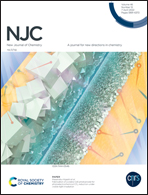Inclusion complexation and self-association of cucurbit[n]uril (n = 6, 7) and diquat under pseudo-physiological conditions†
Abstract
In this study, the formation and steric structure of the inclusion complex of cucurbit[n]uril (CB[n]; n = 6, 7) and diquat (DQ), a representative and widely used bipyridinium herbicide, were investigated through NMR measurements under the pH conditions of human pseudo-gastric or body fluids, in physiological saline. CB[6] did not undergo inclusion complexation, while CB[7] formed an inclusion complex with DQ at a molar ratio of 1 : 1. The steric structure of the observed inclusion complex was as follows: one of the two pyridinium rings of DQ was inside the CB[7] cavity, while its methylene moiety and the remaining pyridinium ring were outside the CB[7] cavity. The thermodynamic parameters showed that the inclusion complexation between CB[7] and DQ was entropy-driven in all the tested solutions, suggesting that the hydrophobic effects were more dominant than the ion–dipole effects in this process. Furthermore, the observed inclusion complex self-associated when increasing the CB[7] and DQ concentrations, and it formed oligomeric species while maintaining its steric structure based on the diffusion coefficient of DQ and the one-dimensional rotating-frame Overhauser effect between CB[7] and DQ.
![Graphical abstract: Inclusion complexation and self-association of cucurbit[n]uril (n = 6, 7) and diquat under pseudo-physiological conditions](/en/Image/Get?imageInfo.ImageType=GA&imageInfo.ImageIdentifier.ManuscriptID=D1NJ06170D&imageInfo.ImageIdentifier.Year=2022)


 Please wait while we load your content...
Please wait while we load your content...